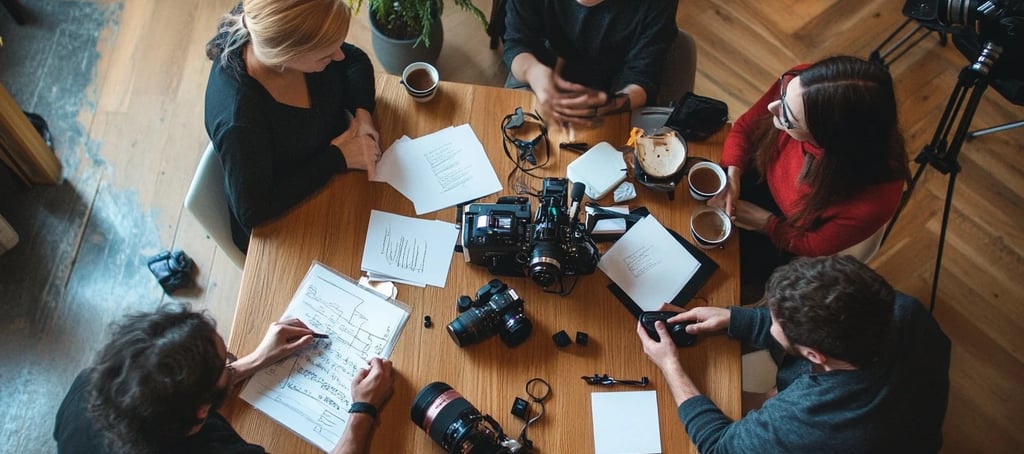The Power of Collaboration in Creative Industries: Working with Other Creatives
Collaboration fuels creativity! Learn why working with other creatives boosts innovation, expands your reach, and helps you grow as an artist, musician, or designer
CREATIVE ECONOMY
Olaotan Olatubosun
2/14/20253 min read


The Power of Collaboration in Creative Industries: Working with Other Creatives
Creativity thrives on connection. Some of the most iconic works in art, music, and film were created by teams of talented individuals working together. Think about it—The Beatles, Pixar, and Marvel Studios didn’t succeed because of one person; they thrived on creative partnerships that brought together unique skills and ideas.
So why do so many creatives try to do everything alone?
If you’re an artist, writer, musician, or designer, collaboration in creative industries isn’t just helpful—it’s essential. It pushes you beyond your limits, introduces new perspectives, and helps you build a network that can lead to new opportunities.
This guide explores the benefits of collaboration for artists, tips for working with other creatives, and the best collaboration tools to help you get started.
Why Collaboration Matters in the Creative World
Collaboration Sparks Innovation
Have you ever felt stuck in a creative rut? Working alone can sometimes limit your ideas, but team projects for artists introduce fresh perspectives. A filmmaker might see something a musician doesn’t, and a designer might offer a visual twist that a writer hadn’t considered. The best ideas often come from combining different artistic visions.
Learning Through Creative Partnerships
Collaboration isn’t just about creating something new—it’s about learning. If you’re a traditional painter teaming up with a digital artist, you’ll naturally pick up techniques from them along the way. Instead of spending hours on online courses, you gain hands-on experience by working together.
Expanding Your Audience and Opportunities
Every creative has their own audience. When you collaborate, you’re not just sharing ideas—you’re also sharing your followers. Whether you’re an independent musician working with a graphic designer on an album cover or a writer teaming up with a filmmaker, collaboration exposes your work to new people, expanding your reach and influence.
Keeping Motivation and Accountability High
It’s easy to lose motivation when working alone. When you’re collaborating, deadlines feel more real because someone else is counting on you. This keeps the momentum going and prevents projects from stalling, leading to higher productivity and better creative results.
How to Collaborate in the Arts: Practical Steps for Success
Finding the Right Creative Partners
The first step to a successful collaboration is choosing the right people. A good collaborator should have a work ethic and commitment level that matches yours, a shared vision or creative style, and strong communication skills. They should also bring a skill set that complements yours rather than overlaps entirely.
Finding the right people is easier when you engage in creative communities. Websites like Behance are great for visual artists and designers, while SoundCloud is ideal for musicians looking to connect. If you’re looking for broader collaboration across different industries, platforms like CollabFinder or even social media groups can be great places to start.
For more insights on branding yourself as a creative professional, visit Building Your Brand as a Creative: Personal Branding for Artists and Creatives.
Setting Expectations and Goals
Before jumping into a project, it’s crucial to define expectations and goals. Are you working together for exposure, skill-building, or profit? Who is responsible for what? How will you communicate—through email, Slack, or Trello? Setting a timeline with clear deadlines will help keep everything on track. Collaboration works best when both parties understand their roles and are committed to the project’s success.
Using the Best Collaboration Tools for Creatives
Technology makes working with other creatives easier than ever. Trello is great for organizing tasks, while Slack helps keep communication streamlined. If you’re collaborating on written or visual projects, Google Drive allows real-time editing and file sharing. Figma is an excellent tool for designers working together, and Notion is perfect for managing ideas and workflows. Using the right tools can save time and frustration, allowing you to focus on the creative process rather than administrative tasks.
Building Long-Term Collaborative Networks
Collaboration shouldn’t just be a one-time event—it should be an ongoing part of your creative journey. By building collaborative networks, you create long-term opportunities for growth and future projects. Engaging with online creative communities, attending industry events, and being open to spontaneous projects can help you maintain strong connections. Instead of waiting for collaboration opportunities to come to you, actively seek out artists, writers, musicians, or designers whose work you admire and reach out. A simple message expressing interest in their work can lead to a meaningful creative partnership.
For more insights on finding creative opportunities and building a thriving career, check out Essential Tools for Success Across Creative Fields.
Final Thoughts: Why You Should Start Collaborating Today
If you’ve been working alone and feeling stuck, collaborating with other creatives could be the breakthrough you need. Whether it’s a small project or a long-term partnership, working with others sparks new ideas, helps you learn and grow, expands your audience, and keeps you accountable. The creative world thrives on collaboration, and the best work often comes from a fusion of different perspectives and talents.
So, who’s your next creative partner?
Start collaborating today and create something extraordinary!